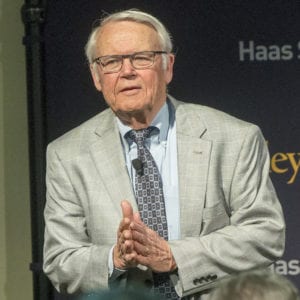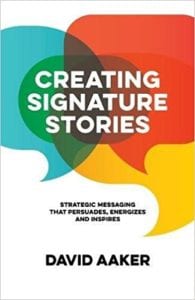In an analysis of hundreds of basketball half-time speeches, Berkeley Haas Professor Emeritus Barry Staw and colleagues found that anger goes farther than inspiration.

It’s a staple of every sports movie: The team is down at the half, and the coach gives an inspirational locker room speech—think Gene Hackman in Hoosiers, Billy Bob Thornton in Friday Night Lights—leading the team to come roaring back to victory. But do pep talks really work?
In a new paper published in the Journal of Applied Psychology, Berkeley Haas Prof. Emeritus Barry Staw and two colleagues, Katherine DeCelles and Peter de Goey, test that question where it counts: the basketball court. Their analysis of hundreds of half-time speeches and final scores from high school and college games found that coaches do better when they shelve the happy talk and bring down the hammer.
In fact, the researchers found a significant relationship between how negative a coach was at half-time and how well the team played in the second half: The more negativity, the more the team outscored the opposition. “That was even true if the team was already ahead at halftime,” Staw says. “Rather than saying, ‘You’re doing great, keep it up,’ it’s better to say, ‘I don’t care if you’re up by 10 points, you can play better than this.’”
This is not the first time Staw has studied basketball. In previous research, he found that NBA coaches were more apt to use expensive draft picks in games—regardless of how well they played—just because they’d paid more for them. Sports, he says, can provide a clear and objective playing field on which to examine behaviors that might not be evident elsewhere.
“In business, there are so many external events and economic factors that it is hard to figure out what is causing organizational performance,” Staw says. “For example, one cannot easily study certain things like the effect of CEO emotions, unless you could convince CEOs to let researchers tape their boardroom talks and office interactions—and even then it would be difficult to figure out whether there are effects on organizational performance.” In basketball, on the other hand, the outcomes are easier to interpret and more definite: the score of your team vs. the opposition.
Analyzing coaches’ emotional expression
The researchers gathered the information for their study by contacting more than 50 coaches for high-school and college basketball teams in Northern California, asking if they could record their half-time locker room talks. Sometimes getting agreement took some doing. “Coaches regard the locker room as their inner sanctum—so it was kind of an achievement just to get the tapes,” he says. One coach dropped out halfway through the study, out of superstition: “The coach complained that every time we taped the game, they lost,” Staw said.
In the end, Staw and his colleagues were left with speeches for 304 games played by 23 teams. They trained coders to rate each halftime talk on the extent that coaches expressed various emotions, ranging from positive (pleased, excited, relaxed, inspired) to negative (disgusted, angry, frustrated, afraid).
Negative speeches can be motivating—up to a point
The results showed two basic effects of coaches’ emotional expression at halftime. First, there was a strong and clear relationship between negative half-time speeches and higher scores in the second half. That is, expressing negative emotion at halftime helped teams perform better in the second half. However, at the most intense end of negative expression, the researchers found somewhat of a reversal of the effect. “We’re talking Bobby Knight–level, when you’re throwing chairs,” Staw says, a reference to the notoriously volatile former Indiana University coach. That is, extremely negative expressions of emotion can impede performance.
The researchers also conducted a controlled laboratory experiment, in which they played selected pep talks for participants, and asked them how motivated or unmotivated they felt after hearing them. Again, Staw, DeCelles, and de Goey found that negative speeches could have a motivating effect, but that the effects of such negativity turned downward rather quickly. In other words, the results showed a more traditional bell curve, where motivation dropped off when the coaches became too angry or too negative.
Not a “license to be a jerk”
Staw notes that in the psychology of leadership, the trend has been to emphasize the idea of “positive affect” driving people to greater performance. A smaller strand of research, however, has surmised that at least in the short term, negative emotion might actually push people to greater effort.
Staw and his colleagues conclude that negative emotion can be underrated as a motivational tool. By expressing anger or dissatisfaction, a leader signals to followers that their performance is not at the level where it should be, potentially driving them to greater effort. “We sometimes strip content from emotion, treating it as simply positive or negative expression, but emotion often has a message carried along with it that causes people to listen and pay attention, as leaders try to correct or redirect behavior,” Staw says.
In a business context, Staw, DeCelles, and de Goey caution against applying the findings too liberally—prolonged negative feedback can lead to demoralized employees. However, in some short-term instances, getting a boost in performance is critical, and the situation may parallel the do-or-die moment at half-time in a basketball game, where expressing anger and disappointment can lead a team to renewed effort and improved results.
“Our results do not give leaders a license to be a jerk,” Staw says, “but when you have a very important project or a merger that needs to get done over the weekend, negative emotions can be a very useful arrow to have in your quiver to drive greater performance.”



 In
In 




 As an undergrad at Berkeley, Ori Brafman had been many things—a peace and conflict studies major, anti-war protestor, and vegan activist whose McVegan campaign had taken on McDonald’s and won. The last place he thought he’d find himself a decade later was in the office of a 4-star army general. “At the time, I had no idea what a 4-star general was,” admits Brafman, BA 97, a Berkeley Haas lecturer who teaches improvisational leadership in the MBA and undergraduate programs. “My first question was, ‘Is there a 5-star general?’”
As an undergrad at Berkeley, Ori Brafman had been many things—a peace and conflict studies major, anti-war protestor, and vegan activist whose McVegan campaign had taken on McDonald’s and won. The last place he thought he’d find himself a decade later was in the office of a 4-star army general. “At the time, I had no idea what a 4-star general was,” admits Brafman, BA 97, a Berkeley Haas lecturer who teaches improvisational leadership in the MBA and undergraduate programs. “My first question was, ‘Is there a 5-star general?’”


 Paternalistic aid
Paternalistic aid Donald or Hillary? Why listening to them matters to voters.
Donald or Hillary? Why listening to them matters to voters.